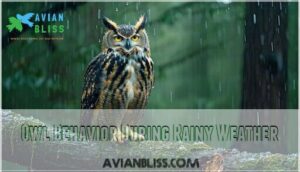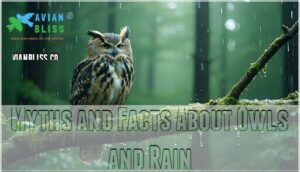This site is supported by our readers. We may earn a commission, at no cost to you, if you purchase through links.
 When an owl launches into wet air, it’s gambling with physics. Rain transforms those silent, precision-engineered wings into waterlogged burdens that make every wingbeat a fight. While owls can technically fly in the rain, their feathers weren’t built for it—unlike ducks with their waterproof armor, owls rely on soft, specialized plumage that sacrifices water resistance for stealth.
When an owl launches into wet air, it’s gambling with physics. Rain transforms those silent, precision-engineered wings into waterlogged burdens that make every wingbeat a fight. While owls can technically fly in the rain, their feathers weren’t built for it—unlike ducks with their waterproof armor, owls rely on soft, specialized plumage that sacrifices water resistance for stealth.
Light drizzle means minor inconvenience, but heavy downpours turn flight into dangerous work. The water weight disrupts lift, vision blurs, and prey vanishes underground just when hunting matters most. What separates a successful flight from disaster often comes down to rainfall intensity and how long those feathers stay soaked.
Table Of Contents
- Key Takeaways
- Can Owls Fly in The Rain?
- How Rain Affects Owl Flight
- Owl Wing and Feather Adaptations
- Owl Behavior During Rainy Weather
- Myths and Facts About Owls and Rain
- Frequently Asked Questions (FAQs)
- Do owls come out when it rains?
- Are owl wings waterproof?
- What do owls do during a storm?
- What do burrowing owls do when it rains?
- How are owls affected by hailstorms?
- Do owls sleep more during rainy days?
- Can owls hunting be enhanced by rain?
- Do owls migrate due to rainy seasons?
- Are owl breeding habits influenced by rain?
- Do owls see better in rain or fog?
- Conclusion
Key Takeaways
- Owls can fly in rain, but their feathers absorb water rather than repel it, making flight harder and more energy-intensive compared to waterproof birds like ducks.
- Light rain allows limited hunting with reduced success, while heavy downpours force owls to shelter completely since wet feathers disrupt lift, blur vision, and drain energy reserves quickly.
- Rain affects owl survival by reducing prey availability, increasing hypothermia risk from wet plumage losing insulation, and threatening chick survival when parents can’t hunt during prolonged storms.
- Owls traded waterproofing for silent flight through specialized feather structure, giving them a stealth advantage in dry conditions but leaving them vulnerable when weather turns wet.
Can Owls Fly in The Rain?
Yes, owls can fly in the rain, but it’s not their preference. Rain affects their flight ability depending on how heavy it falls and how long they stay airborne.
Let’s look at what actually happens when these birds take to wet skies.
Physical Ability to Fly During Rain
Yes, owls can fly in the rain, but their feathers aren’t built for it like a duck’s would be. Their wings work through specialized feather aerodynamics that create silent flight.
When water saturation occurs, wing load increases and flight stability drops. The added weight strains their flight muscles, leading to muscle fatigue.
You’ll notice owls can still take off and maneuver, but wet conditions make every wingbeat harder.
Impact of Light Versus Heavy Rainfall
The difference between a light drizzle and a downpour matters a lot for owl flight capability. Here’s what you need to know:
- Light rain allows owls to hunt with minor feather saturation and decent visibility reduction
- Moderate rain decreases flight stability and impacts thermal regulation noticeably
- Heavy downpours force owls to ground themselves as prey availability drops
- Torrential storms create dangerous conditions where flight becomes nearly impossible
Observed Owl Behavior in Wet Weather
Beyond rainfall intensity, owls show clear patterns when storms arrive. Hunting success drops sharply as prey hide underground. Roosting duration increases considerably, sometimes lasting entire days. You’ll notice increased preening frequency once rain stops to restore feather waterproofing. Vocalizations change too—owls call less during heavy rain.
For breeding pairs, prolonged wet weather severely impacts chick survival since parents can’t deliver adequate food. This is because rain affects acoustic communication, reducing their calling range.
How Rain Affects Owl Flight
Rain doesn’t just make owls wet—it changes how they move through the air. When water soaks their feathers, several problems stack up that make flying harder and riskier.
Let’s look at what happens to an owl when it takes off in the rain.
Changes in Flight Performance
When rain starts falling, an owl’s wings don’t slice through the air quite the same way they do on a dry night. Water weighs down the feathers, disrupting feather aerodynamics and causing lift reduction. You’ll notice speed variation as the bird compensates, and maneuvering impact becomes clear when quick turns feel sluggish. Altitude control also suffers since wet wings can’t grip air efficiently.
- Your heart might ache watching an owl struggle mid-flight, wings heavy and uncertain.
- Imagine the frustration of losing precision when survival depends on split-second reactions.
- Picture the vulnerability when every wingbeat demands twice the effort just to stay airborne.
Increased Energy Expenditure
Flying with soaked feathers forces an owl to burn fuel like a car stuck in mud—every wingbeat costs more, and the body’s energy reserves drain fast. You’ll see the metabolic rate spike as muscles work harder.
Thermoregulation challenges kick in when wet plumage loses insulation. Flight efficiency drops, so hunting success plummets.
Feather maintenance afterward demands even more calories the bird can’t afford to spare.
Risks of Flying in Wet Conditions
Disorientation from poor visibility turns every flight into a gamble. Owls colliding with trees, power lines, and vehicles when rain blurs their world. Feather waterlogging adds dangerous weight, while sensory impairment cuts hunting accuracy in half. Injury risks spike at wildlife hospitals during storms.
Juvenile threats multiply—inexperienced birds can’t judge shelter or avoid hazards. Roosting dangers include hypothermia and predator encounters when owls hunker down.
Owls possess specialized waterproofing mechanisms to help mitigate these effects.
Owl Wing and Feather Adaptations
Owls have special wing and feather designs that help them survive in different weather conditions. These adaptations don’t make them waterproof, but they do affect how well owls can manage wet conditions.
Let’s look at the key features that shape how owls deal with rain.
Structure of Owl Wings and Feathers
Owl wings are built like precision instruments, with specialized feathers arranged in layers that serve different jobs during flight. Here’s what makes them work:
- Primary flight feathers form the wing tip and generate forward thrust
- Secondary flight feathers create lift along the inner wing
- Contour feathers shape the wing surface for smooth airflow
- Down feathers provide insulation properties near the body
- Feather microstructure includes tiny barbs that lock together like velcro
Wing shape varies by species. Feather maintenance through preening keeps everything functional.
Water Resistance Versus Absorption
Unlike ducks or seabirds, owl feathers lack significant waterproofing. Feather microstructure absorbs moisture rather than repelling it because owls produce minimal oil from their uropygial gland. This limits hydrophobicity mechanisms that other species rely on.
Preening importance increases during wet periods, but feather degradation occurs when prolonged rain saturates the plumage, compromising their silent flight advantage.
Comparison With Other Bird Species
When you stack owls against waterfowl, raptors, or songbirds, the differences in feather design tell you everything about who’s built for wet weather and who’s not. Waterfowl adaptations include dense oil coating that sheds water instantly. Seabird strategies rely on similar waterproofing.
Meanwhile, songbird vulnerability mirrors owl challenges—both absorb moisture quickly.
Raptor differences appear in hunting styles, though most diurnal raptors fare better in rain than owls due to flight variations and less specialized plumage requirements.
Owl Behavior During Rainy Weather
When rain falls, owls don’t just keep hunting like nothing happened. Their behavior shifts in ways that help them stay safe and survive.
Let’s look at the specific strategies they use when weather turns wet.
Roosting and Shelter-seeking Strategies
Rain doesn’t just ground owls—it sends them scrambling for the best shelter they can find. Roost selection becomes critical during storms. You’ll find owls choosing shelter types with dense overhead cover:
- Tree cavities with solid canopies
- Dense coniferous branches that deflect water
- Urban roosts like barns and building eaves
Group roosting sometimes occurs, though most species prefer rain avoidance through solitary, protected spots.
Hunting and Foraging Adjustments
Once you find the right shelter, your next problem hits hard—you still need to eat, and rain makes hunting much harder. Prey availability drops as rodents hide. Your sensory adaptations—especially sound detection—decline when raindrops mask rustling. You must adjust hunting techniques, switching to visual cues or waiting out storms.
| Rain Condition | Hunting Response |
|---|---|
| Light drizzle | Brief flights, reduced success |
| Moderate rain | Extended roosting, minimal foraging |
| Heavy storms | Complete hunting suspension |
This creates significant energetic costs while territory defense weakens.
Effects of Prolonged Rain on Survival
If days of steady rainfall drag on, your survival margins shrink fast. Feather waterlogging reduces lift, body temperature regulation fails, and starvation becomes a real threat when hunting stays impossible.
Food scarcity weakens adults while chick vulnerability increases dramatically. Hypothermia risk climbs as wet plumage loses insulation.
Disease spread accelerates in damp roosts, and habitat degradation from flooding forces owls into marginal territories where competition intensifies.
Myths and Facts About Owls and Rain
You’ve probably heard some interesting stories about owls and rain. Some people think owls can’t get wet at all, while others believe they’re completely waterproof.
Let’s clear up the confusion by looking at what’s really true and what’s just myth.
Common Misconceptions About Owls in Rain
Many people believe owls can’t get their feathers wet at all, but that’s not quite how it works. Here are common owl rain myths you might’ve heard:
- Owls are completely waterproof – Their feathers offer limited water resistance, not full waterproofing effectiveness.
- Rain blinds owls entirely – Visibility during rain decreases but doesn’t vanish.
- Wet owls can’t hunt – Hunting success rates drop, yet they can catch prey.
- All owls roost identically – Rainy roosting habits vary by species.
Scientific Research Findings
Beyond common beliefs, laboratory studies reveal how owls really manage wet conditions. Researchers measured wing airflow resistance at 950 Pa·s/m³, which is 23% lower than other birds. Their soft feather texture reduces drag while generating a turbulent wake that maintains lift even in challenging weather.
Laboratory studies show owl wings achieve 23% lower air resistance than other birds, creating turbulent wakes that preserve lift even in wet conditions
High-speed imaging shows owls fly at lower flight speeds but use greater power output. Scientists even developed bioinspired materials based on owl feathers for noise reduction technology.
Insights From Ornithologists and Birdwatchers
Across Field Studies spanning decades, ornithologists confirm owls can fly in rain, though most avoid it. Expert Observations from Data Collection show clear patterns:
- Barn owls shelter during moderate rainfall but hunt in light drizzle
- Great horned owls continue territorial flights even in steady rain
- Behavior Analysis reveals owls assess prey availability against flight costs
- Younger birds show poorer judgment about weather risk
- Conservation Implications include habitat loss forcing flight in poor conditions
These findings guide wildlife management decisions.
Frequently Asked Questions (FAQs)
Do owls come out when it rains?
Most owls don’t voluntarily come out when it rains. Rainy-day activity drops sharply because wet conditions reduce hunting success and owl visibility. Prey behavior changes, and shelter preference wins.
Picture a barn owl tucked into a hollow tree during a storm.
Are owl wings waterproof?
No, owl wings aren’t truly waterproof. Feather microstructure and oil gland function provide some water repellency through preening effectiveness, but their insulation properties decline when saturated.
Unlike waterbirds, owls lack strong waterproofing adaptations.
What do owls do during a storm?
When storms hit, owls hunker down in Storm Shelter spots like dense trees or rock crevices. Parental Care intensifies as adults shield chicks from harsh conditions.
Food Scarcity becomes critical during prolonged weather events, affecting Chick Survival rates and triggering Behavioral Changes in hunting patterns.
What do burrowing owls do when it rains?
When rain arrives, burrowing owls retreat into their underground shelters for protection. These burrows keep adults and chicks dry while safeguarding nest protection and any food storage.
However, prolonged storms create flood risks that can threaten chick survival in low-lying areas.
How are owls affected by hailstorms?
Hailstorms pose serious threats to owls through direct injury and disrupted hunting. Ice pellets can cause head trauma, wing damage, and increase mortality rates. Shelter availability becomes critical as owls seek dense cover.
Behavioral changes include extended roosting periods and delayed foraging until conditions improve.
Do owls sleep more during rainy days?
During rainy weather, you’ll notice behavioral changes in owls related to energy conservation. They tend to rest more and show hunting inactivity, altering their sleep-wake patterns as rainy day rest helps them preserve energy.
Can owls hunting be enhanced by rain?
In some cases, yes. Light rain can increase Prey Availability by driving small mammals from burrows.
However, Sound Masking from heavy rainfall often disrupts hunting success since owls rely on hearing prey movements beneath vegetation or snow.
Do owls migrate due to rainy seasons?
When weather patterns shift like clockwork, some creatures follow ancient routes. Most owls don’t migrate due to rainy seasons.
Rainfall and migration patterns link more to prey availability and breeding season timing. Habitat changes from climate impact matter more than seasonal storms.
Are owl breeding habits influenced by rain?
Yes, precipitation patterns affect breeding timing, nesting success, and chick survival rates. Heavy rainfall can reduce food availability during critical nesting periods. Some species adjust habitat selection based on local moisture conditions to improve reproductive outcomes.
Do owls see better in rain or fog?
Visual acuity suffers more in rain than fog. Owls rely on remarkable vision, but heavy rain disrupts light and creates visual noise. Fog reduces contrast yet remains more predictable.
Sensory adaptations like acute hearing compensate during both environmental conditions, maintaining hunting success.
Conclusion
The next storm won’t surprise you anymore. You now understand that can owls fly in the rain isn’t a simple yes or no—it’s a calculation these birds make every time clouds gather.
Their feathers traded waterproofing for silence, leaving them vulnerable when skies open up. Light rain poses manageable challenges, but heavy downpours force owls into survival mode, sheltering until conditions improve.
Nature equipped them for darkness and stealth, not storms—a trade-off that shapes every decision they make when raindrops start falling.
- https://birdqueries.com/can-owls-fly-in-the-rain/
- https://pmc.ncbi.nlm.nih.gov/articles/PMC3390528/
- https://owl-lovers.com/can-owls-fly-in-the-rain/
- https://beaverhillbirds.com/publications/climate-change-blog/impacts-of-climate-change-on-owls/
- https://appliedecologistsblog.com/2015/11/16/extreme-rainfall-will-pose-a-challenge-for-management-of-endangered-burrowing-owls-in-canada/









